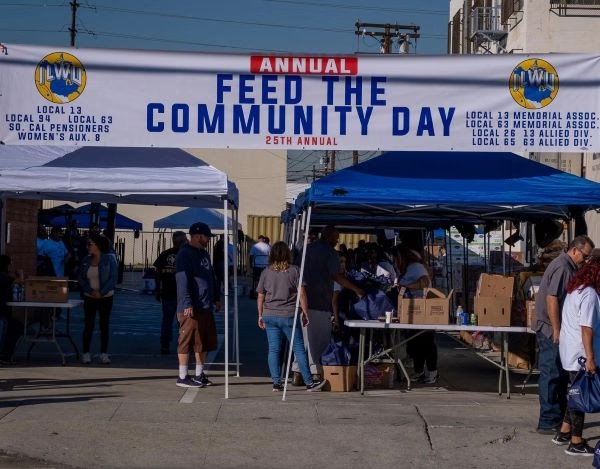Trump’s SNAP Cut-Off Is Just One Facet of a Multi-Layered Rollback of Food Aid
From its very first day, the Trump administration cut off food and medical aid for children. It began with children primarily in Africa and Asia, but now it’s coming for American kids, with skyrocketing health care costs and cut backs in food aid both threatening to kick in ahead of the holidays.
The government is shut down as Democrats are demanding the extension of Affordable Care Act marketplace subsidies, without which millions of Americans will no longer be able to afford health care. And the Trump administration has been using the shutdown as an excuse to cut off food stamps (Supplemental Nutrition Assistance Program, or SNAP) for 42 million Americans, even though there was no such cut-off the last time Trump was in office during a shutdown.
“No American should have to worry about whether they can afford their next meal,” said Rep. Nanette Barragán on Oct. 28 in a press conference at Toberman Neighborhood Center. But for one in every eight Americans — and almost one in every four children — that was set to happen with the threatened cut-off of SNAP benefits on Nov. 1, before two courts intervened on Oct. 31.
“Irreparable harm will begin to occur if it hasn’t already occurred in the terror it has caused some people about the availability of funding for food for their family,” U.S. District Judge McConnell of Rhode Island said in his oral ruling. But Trump, who held a lavish Great Gatsby-themed party at Mar-a-Lago later that same day, still refused to simply do what he did in the last shutdown, pretending there was some confusion. Then on Nov. 3, his lawyers said that only half-payments would be made, using the existing contingency fund, but nothing more, and that payment delays could last “months.” Trump then posted on social media that no funds would be released until the shutdown ended. Regardless of what happens next, it’s just the sharpest and most recent blow against food security from the Trump administration.
“Every day at Toberman Neighborhood Center, we see parents skipping meals so their children can eat and seniors stretching what little they have just to survive. When programs like SNAP are delayed or held back, it’s not numbers on a page; it’s families in crisis,” said Toberman CEO Dr. Lupe Rivera, who called the cut-off “a direct threat to the health, education and stability of our families who are already pushed beyond their limits.”
In the first weeks of the Trump administration, almost half a billion dollars worth of foreign food aid was cut off, with shipments frozen in place and left to rot, as children were starving in Asia and Africa. Now San Pedro, Wilmington and Carson are in the cross-hairs, along with every other community in America, as Trump is holding back 10 times as much food aid. Of the 42 million people nationwide, there are 1,548,619 recipients in LA County, and approximately 133,540 individuals in Random Lengths’ circulation area, according to data provided by county officials. This includes 488,184 children 18 years or younger countywide, and approximately 39,700 children in our circulation area.
The numbers help to grasp the full magnitude of the devastation being caused, but it’s felt at the individual level.
“At Toberman, we see this human side of suffering every single day,” Rivera said. “It is a mother, who skips dinner for her child to have something to eat. It is a senior who chooses between groceries and medication. The teenager who struggles to concentrate in class, not because of a lack of motivation, but because their body is fighting exhaustion and hunger at the same time.”
The last is particularly tragic. “For youth, the effects of hunger begin quickly. Within hours, the body begins to lose energy, the brain struggles to focus and over time the consequences become severe, and the youth suffer long-term health issues. Let me be clear about something: hunger steals potential. This is why our work matters,” she said. “Programs that support housing, education, employment, yes they are definitely critical. But none of them can succeed without the basic nutrition. … Hunger halts progress and multiplies inequity.”
To help address the emergency, the county has directed $10 million to the LA Regional Food Bank, and has mobilized internal giving systems as well. But the food crisis comes in the shadow of the looming health care crisis as well, Supervisor Janice Hahn noted. “Hardworking LA County residents can’t afford to see their health care premiums double and I am proud of our members of Congress who are fighting hard to prevent it,” Hahn said. “While their fight continues, the county stands ready to meet this moment and we have marshalled resources to get food to people who need it during this shutdown.”
The cut-off was just the latest and most dramatic of Trump’s many attacks on food security, along with a recent attack on knowing the consequences. During his first 100 days, Trump cancelled multiple food and agricultural programs, including three that totaled roughly $1.6 billion. One provided $500 million to deliver food directly to food banks. Locally, this resulted in the cancellation of 107 truckloads of food scheduled for the Los Angeles Regional Food Bank. The other two provided funding for schools and state, tribal and territorial governments to purchase food produced locally or regionally. These were funds appropriated by Congress which Trump illegally and unconstitutionally cancelled.
Then, in July, the GOP budget bill cut $186 billion from SNAP (known as CalFresh in California) in addition to $1.1 trillion cut from Medicaid and the ACA marketplace — all to give massive tax cuts to the wealthy and large corporations. This translates into 4 million people losing benefits, and another 19 million facing benefit cuts, with different cuts coming in stages, starting Oct. 1. In California, at least 754,000 people could lose their entire monthly benefit, including 74,000 lawfully present noncitizens such as asylum seekers, refugees, parolees and trafficking victims, and another 3 million households face reductions according to the California Budget & Policy Center.
The impacts of these cuts will be more difficult to trace because of another Trump administration action: In September, it announced the cancellation of the annual hunger survey, which has been in place since the mid-1990s. Not only will it make the problem of hunger and food insecurity more difficult to track, the cancellation violates the spirit, and possibly the letter of a law that Trump himself signed in 2019, the Foundations for Evidence-Based Policymaking Act.
The SNAP cuts in the budget bill were implemented by a multi-layered increase in what’s known as administrative burdens, bureaucratic requirements (often justified to fight fraud and abuse), which have the actual effect of significantly reducing the number of qualified recipients who receive aid.
On Oct. 1, sociologist Pamela Herd wrote a substack post explaining how this was done. She’s the co-author of Administrative Burden. Policymaking by other Means, the landmark book on the subject. Abortion access and voting rights were two prime examples Herd cited from the book, when Random Lengths spoke with her, saying that “conservatives at least for a while had been using the strategy,” but “The Trump administration has taken it to a different level in terms of the extent to which they’re employing them,” in concert with Republicans in Congress.
This applied to added work requirements for Medicaid in their budget bill, for example. “Most of the people who will lose coverage are not going to lose coverage because they are no longer eligible. They’re going to lose coverage because they can’t figure out how to document that they’re meeting these work requirements. And states will really struggle to have sufficient capacity to implement those changes without just kicking a lot of people off the program unintentionally,” she said.
“The same with food stamps, changes to SNAP,” she added. More subtly, they’re “shifting a lot of SNAP costs to states by charging them more when states make errors,” which are inevitable, given “the complicated design eligibility structure for snap,” she noted. “But now when they make those mistakes, the federal government is going to charge them a lot of money.” As a result, North Carolina is dropping SNAP entirely. “They designed the legislation to put states in this box, this impossible position,” Herd summed up.
Here in LA County, the projected number of those who must meet work requirements currently is 211,281, according to the Department of Social Services. Its error rate of 10.16% is below the statewide and national averages, both of which are 11.35%. But this error rate itself is somewhat erroneous, as it includes errors that have no bearing on eligibility.
Locally, the cut-off threat was dire.
“The withholding of $317 million from the LA County economy each month the government shutdown continues will have a multiplier effect on businesses, specifically grocery stores, farmers markets and food retailers in low-income communities,” a representative from the LA County Department of Public Social Services told Random Lengths via email. “According to the USDA, every SNAP/CalFresh dollar spent stimulates $1.54 in economic activity, all of which will come to a halt as CalFresh benefits are withheld. The USDA research further indicates that 80% of SNAP/CalFresh benefits are spent within two weeks of being issued; this does not only meet the household’s food purchasing needs but also supports local jobs and contributes to economic output. With this delay, businesses will see direct and immediate decline in revenues.”
While the massive hit of a complete cut-off seems to have been avoided as Random Lengths goes to press, the long-term reductions in SNAP spending will have similar harmful effects. They will be less dramatic, less headline-grabbing, but for those losing benefits, the effects will be just as devastating. And with skyrocketing healthcare costs from the GOP budget bill, more and more people will be needing SNAP to get by, even as the program is forced to shrink.



